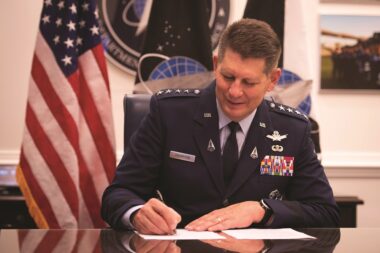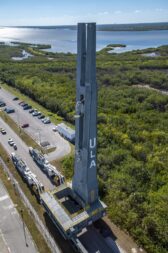At the start of 2021, key questions loomed for the U.S. military space community: Would the Space Force survive under President Biden? Could the Defense Department’s space agency really build a megaconstellation? And when would United Launch Alliance fly the long-awaited Vulcan Centaur, a vehicle that the Pentagon is counting on to deliver critical national security satellites to orbit.
A year later, the Space Force stands on firmer political ground but is coming under pressure to deliver new technologies to counter threats from Russia and China. The Space Development Agency is counting down to the launch of its first operational satellites. And ULA is still waiting for Blue Origin to deliver engines for Vulcan’s maiden flight.
Here’s a glimpse of what’s in store for the year ahead:
GROWING FOCUS ON RESILIENCE AGAINST MILITARY THREATS
At the first meeting of the Biden administration’s National Space Council on Dec. 1, Vice President Kamala Harris said a top concern going forward is to keep space safe for military, civilian and commercial operations.
The meeting took place just two weeks after Russia’s military launched a Nudol ballistic missile that intercepted a defunct Soviet-era satellite in low Earth orbit. An estimated 1,500 pieces of space debris created by the anti-satellite test are still being identified and cataloged by U.S. Space Command.

Pentagon officials condemned Russia’s test as a hugely irresponsible act that served as a wake-up call about the dangers posed by anti-satellite weapons. In the face of these threats, the onus will be on the Space Force to develop more resilient systems it can defend against missile strikes, electronic jamming and cyberattacks.
This year, a priority for Air Force Secretary Frank Kendall will be to energize the Space Force’s procurement bureaucracy to acquire advanced technologies needed to protect satellites and compete with rival powers China and Russia.
Gen. David Thompson, vice chief of space operations of the Space Force, said China is developing space capabilities faster than the United States. “If we don’t start accelerating our development and delivery of capabilities, they will exceed us,” he said in December at the Reagan National Defense Forum.
SPACE FORCE PROCUREMENT UNDER NEW MANAGEMENT
President Biden in December nominated former National Reconnaissance Office executive Frank Calvelli to be assistant secretary of the Air Force for space acquisition. If confirmed by the Senate, Calvelli will become the first-ever senior procurement executive in charge of U.S. military space programs, a post mandated by Congress in the 2020 National Defense Authorization Act.
Congress in 2022 will be watching closely how this new office is organized and what novel approaches it might bring to space procurements.
Since the Space Force was established two years ago, lawmakers have criticized the service for the slow pace of its acquisition programs and for not inserting innovative commercial technologies into military systems. During hearings on Capitol Hill about satellite procurements, the Space Force has often found itself compared unfavorably to the NRO, which uses a more streamlined process in its acquisitions.

Rep. Jim Cooper (D-Tenn.), chairman of the House Armed Services strategic forces subcommittee, noted that one of the reasons he advocated for a separate military space service was “because the Air Force was neglecting its space mission and not performing as well as the NRO.”
Kendall said a reorganization of the Space Systems Command – the Space Force’s main technology developer and procurement arm – is expected to begin in 2022.
A restructuring of the acquisition bureaucracy may not deliver results overnight, but “it’s difficult to argue that there is no room for improvement,” said space industry analyst Andrew Penn of the consulting firm Avascent.
The Space Systems Command (previously known as the Space and Missile Systems Center) “has not been known for being the most efficient organization,” he said. “How an organization structures itself directly affects its ability to meet its objectives and perform its mission,” he added. On what specific improvements this reorganization will accomplish, “time will tell.”
DOD’S PIVOT TO LOW EARTH ORBIT
A key element of the nation’s strategy to protect satellites from attack will be to field them in large numbers, as more targets make it more expensive for enemies to take down a space network. To this end, a critical development to watch in 2022 is the Space Development Agency’s planned launch of its first batch of satellites in low Earth orbit.
This initial deployment will serve as the foundation of a military megaconstellation that could number close to 1,000 spacecraft by 2026. SDA will field sensor satellites to find missiles and hypersonic weapons. SDA will also deploy communications satellites to disseminate information rapidly to warfighters. These LEO networks will supplement existing legacy satellites in geostationary orbit that the Pentagon fears will come under attack during a conflict.

The SDA’s accelerated timeline is unusual in military programs, so pulling off a 2022 launch as promised would be a significant achievement for the less than three-year-old agency that chose as its motto Semper Citius, Latin for “always faster.”
No matter how technically advanced or how affordable a program is, “if it is not there when you need it, it’s worthless,” said SDA Director Derek Tournear.
SDA’s success could significantly impact DoD’s role as a customer of the commercial space sector, said industry analyst Chris Quilty of Quilty Analytics.
The proliferated architecture planned by SDA also puts DoD in a position to take advantage of lower-cost commercial technologies and “strengthen a vibrant ecosystem of companies, both established and new space,” said Quilty. “By bulk ordering approximately 150 satellites every two years, SDA can maintain a strong and diverse domestic supplier base while mitigating protests.”
The SDA later this year will transfer from the Office of the Secretary of Defense to the Space Force, a reorganization scheduled for October.
Some have questioned whether the realignment risks introducing slow and cumbersome DoD procurement habits into SDA’s more agile processes. Penn, the industry analyst, said the transition should be relatively smooth. He compared it to an established company acquiring a startup and letting it continue to operate as a quasi-independent subsidiary, at least for the first several years.
“I do not think the Space Force would meaningfully interfere in the SDA’s first few acquisitions,” he said. “Over time, that may change. But an early SDA failure, whether it be spacecraft performance, schedule, or cost-related, would undermine both organizations and the national security of the nation,” Penn added. “Ultimately, both organizations share the same goal of delivering timely and resilient space-based capabilities to the warfighter and will work together to achieve that goal.”
NEXT STEPS FOR THE MILITARY SPACE ARCHITECTURE
Companies in the defense and space industries in 2022 will be watching how the Space Force moves forward with the design of next-generation systems.
A hint of what’s to come was provided in late 2021 by the Space Warfighting Analysis Center (SWAC), a newly created Space Force organization responsible for conducting analysis, modeling, wargaming and experimentation to create operational concepts and force design guidance for the service.
The SWAC’s first project is to design the future missile warning architecture, or what mix of satellites in what orbits would be needed to detect and track enemy missiles and hypersonic glide vehicles. Compared to the traditional approach for developing military systems — publishing a list of requirements and asking contractors for bids on satellites built to spec — the SWAC asks companies to submit digital models.
Andrew Cox, the director of the SWAC, said the industry’s digital models would be used in wargames and simulations to determine if the proposed satellite designs are resilient to attacks.
Many in the space industry think the SWAC is “an excellent idea on paper,” said Penn. “A single clearinghouse looking at the big picture and engaging with industry in a fundamental way that aligns capability with customer needs could be very beneficial,” he said. “What remains to be seen is how much influence it will have.”
NRO’S SELECTION OF COMMERCIAL IMAGERY SUPPLIERS
The U.S. satellite imagery industry is eagerly awaiting a decision this year by the National Reconnaissance Office. The agency is expected to select domestic companies to join Maxar Technologies as the NRO’s main suppliers of satellite imagery. This procurement, known as the Electro-Optical Commercial Layer (EOCL), will replace the current single-vendor agreement signed with Maxar more than a decade ago.
The NRO operates the nation’s spy satellites and procures commercial imagery for the military, homeland security organizations and the intelligence community.
NRO imagery deals are a major opportunity for emerging players like Planet and BlackSky, said Quilty, the industry analyst. The NRO currently pays Maxar $300 million a year for access to the company’s high-resolution imagery satellites and image archive. The company’s contract has been extended until August 2022, so the question now is how many suppliers besides Maxar will receive EOCL contracts, and will the NRO raise overall spending on commercial imagery above $300 million.
Pete Muend, director of the NRO’s commercial imagery program, has insisted that the agency wants to take advantage of private-sector capabilities as a legitimate alternative to government-owned spy satellites. The NRO will be looking for a mix of vendors that can provide high-resolution imagery, rapid refresh rates and complementary phenomenologies that work together to give government analysts a more comprehensive intelligence picture.
“It’s very important to make sure that there is U.S. space leadership in the future. And a big part of that is commercial space leadership,” Muend said. “And so we’re very focused on making sure that the U.S. enterprises involved in commercial space are at the forefront and do what we can in order to help enable that.”
Also on the horizon in 2022 is the NRO’s plan to procure synthetic aperture radar (SAR) imagery from a growing cadre of commercial vendors.

A DECISIVE YEAR FOR NATIONAL SECURITY SPACE LAUNCH
United Launch Alliance a year ago was projecting a 2021 debut for Vulcan Centaur, a heavy-lift rocket powered by the BE-4 engine made by Jeff Bezos’ Blue Origin. But meeting that goal was hugely dependent on Blue Origin completing engine development and delivering two flight-ready BE-4s.
Those engines have not yet been delivered, and Vulcan’s first flight timetable continues to shift to the right.
ULA now projects receiving engines in mid-2022 and flying Vulcan by year’s end. Meanwhile, ULA’s margin for schedule slippage keeps shrinking as Vulcan must complete two successful launches — for commercial customers Astrobotic and Sierra Space — before it can be certified by the U.S. Space Force to fly national security missions. ULA so far has been assigned four missions under its National Security Space Launch Phase 2 contract. ULA got the top score in the NSSL competition, edging out SpaceX to claim a 60 percent share of the up to 35 missions covered under the contract.
Due to Vulcan delays, ULA’s first Phase 2 mission has already been reassigned to the company’s legacy rocket Atlas 5. ULA’s CEO Tory Bruno said Vulcan will be ready for NSSL missions in 2023. If that doesn’t happen, using the Atlas 5 would no longer provide a backup option. ULA sold its remaining Atlas 5 inventory to Amazon to launch the Project Kuiper internet constellation.
If Vulcan is not ready for NSSL launches by 2023, the next option for the Space Force would be to reassign ULA’s missions to SpaceX. “The reason to have two launch providers is that if something happens to one, and you’ve got another one to rely on,” noted Kendall, the U.S. Air Force secretary.
2022 A BIG YEAR FOR SPACE LAUNCH WRIT LARGE
The space industry could see as many as four or five commercial heavy rockets debut in 2022. Besides ULA’s Vulcan, Blue Origin’s New Glenn projects its first launch late in the year, as well as two new international heavy launch competitors: Europe’s Ariane 6 and Japan’s H3. SpaceX is also targeting the first orbital test of its Starship vehicle.
In 2021 Virgin Galactic flew humans to space, Blue Origin twice flew its New Shepard suborbital vehicle with crews on board, and SpaceX’s Crew Dragon made its first commercial flight with private astronauts. “If 2021 was the year of commercial space tourism, then 2022 might be the year of the next-gen heavy launcher,” said Penn, the industry analyst.
“Never in history have so many heavy launch vehicles debuted in the same year,” he said.
Also expected to fly for the first time in 2022 are small launch providers Relativity and ABL Space Systems, both of which have won contracts to launch military payloads.
“I’m excited about them,” said Penn. Having additional players in the launch industry not only brings new capabilities to government and commercial markets but also helps bring down the price of launch, he said. If both Relativity and ABL Space start flying, “that would certainly be welcomed by smallsat operators and bring added competition to the dedicated small launch market.”
Other small satellite launchers to watch in 2022 are Virgin Orbit and Astra Space, both of which have won military contracts. Virgin Orbit launched twice in 2021 and has forecast six missions for 2022. Astra Space is expected to pick up its cadence next year after completing its first orbital launch in 2021.
This article originally appeared in the January 2022 issue of SpaceNews magazine.
#Space | https://sciencespies.com/space/space-and-national-security-what-to-expect-in-2022/
No comments:
Post a Comment